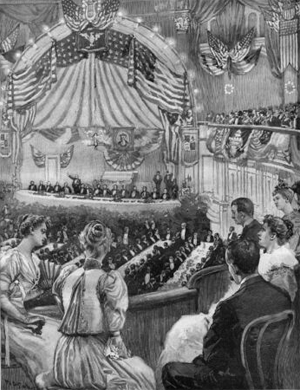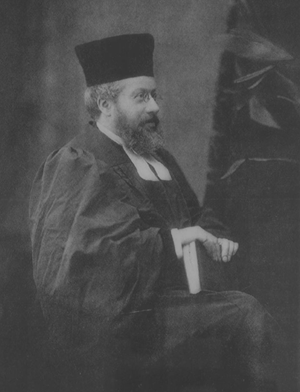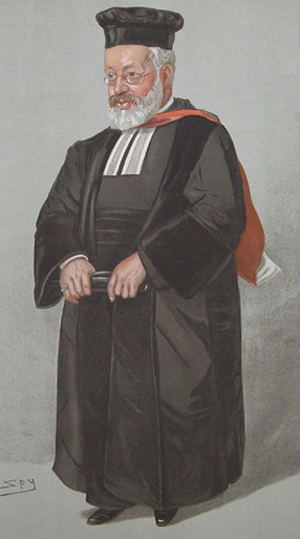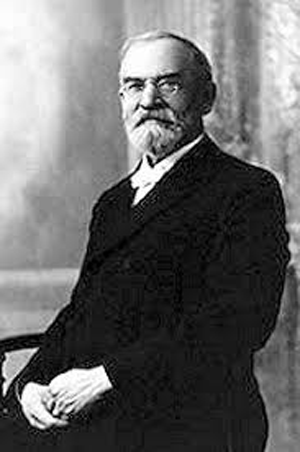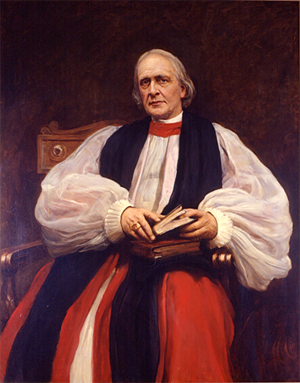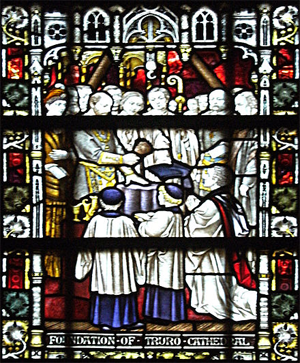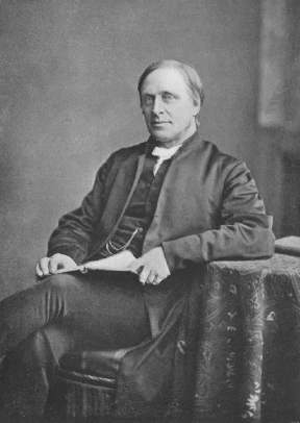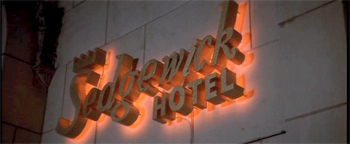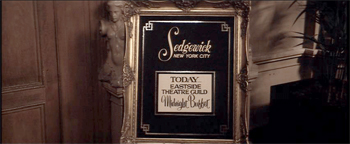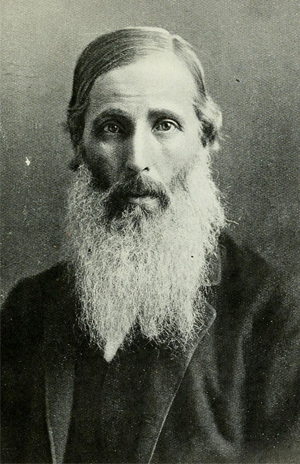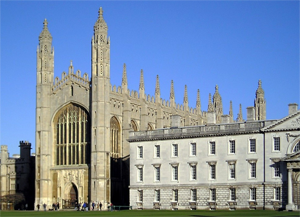by United States Supreme Court
1876
NEW YORK COLUMBIAN CELEBRATION, LENOX LYCEUM BANQUET
Over eight hundred persons sat down to dinner in the Lenox Lyceum, James C. Carter, Esq., of the Bar of New York, presiding and acting as toastmaster.
Across one end of the hall, on a raised platform, in an arc of the Circular Hall, was the guests’ table, in the centre of which, facing the audience, was Mr. Carter; and to the right and left of him sat twenty-four other guests, including the Justices of the Supreme Court. The other tables were ranged down the room, at right angles with the guests’ table, and were lettered from A to N. Tables A and L, at the extreme left and right, seated each twenty-six persons. Table B., next A to the left, and Table K. next L to the right, each seated fifty persons, each being nearer the centre of the room, and gaining additional length from its circular shape. Tables C, D, E, F, G, H, I and J, situated between B and K, each seated seventy-four persons. Tables M and N were in the arc of the circle opposite the guests’ table, and beyond the other tables, and seated eighteen persons each. In addition to these there was a table for the press, with accommodations for sixteen reporters. A plan of the room was given to each person. It showed the arrangements of the table, and the seat to be occupied by each person, and was accompanied by an alphabetical list, designating the table, and the number of the seat at it, assigned to each person; and it thus deprived even the most inveterate grumbler, if such is to be found in the ranks of the law, of the power of complaining that he could not find his place.
In addition to these plans, each person present was furnished with a sumptuously printed pamphlet entitled “Judicial Centennial Banquet given at the Lenox Lyceum, New York, February 4, 1890.—The New York State Bar Association, The American Bar Association, The Association of the Bar of the City of New York.” This contained the plans already referred to, and also a list of the “Invited Guests,” and another list, entitled “Members of the Associations,” with the names of those who had signified an intention to be present. The reporter has necessarily been obliged to depend upon these lists, supplemented by the personal recollections of some members of the executive committee. Although, in so large a company there may have been, and probably were, some who had intended to come, and who at the last moment stayed away; and others who also at the last moment embraced the opportunity of filling a vacated seat; yet, it is believed that the lists of committees, of invited guests and of members of the Associations present which are contained herein are substantially, if not entirely, accurate. Even name here given is to be found either among the invited guests, or among the members of the Associations, or on the plan of the seats of the tables.
At the table of the Presiding Officer were to have been seated the President, the Vice-President and the Attorney General, all of whom were, as has been said, detained in Washington. There were seated at this table the Chief Justice and Associate Justices of the Supreme Court; Mr. Justice Strong (retired); Mr. Grover Cleveland, Chairman of the Executive Committee; Mr. Matthew Hale of Albany, President of the New York State Bar Association; Mr. Henry Hitchcock of Missouri, President of the American Bar Association; Mr. Frederic R. Coudert of New York, President of the Association of the Bar of the city of New York; Mr. William H. Arnoux of New York city; Mr. Joseph H. Choate of the city of New York; Mr. Hugh J. Grant, Mayor of New York; Mr. William Maxwell Evarts, a Senator in Congress from the State of New York; Mr. Edward M. Paxson, Chief Justice of the Supreme Court of Pennsylvania; Mr. Walter B. Hill of Georgia; the Reverend Dr. William R. Huntington, Rector of Grace Church, New York City; Mr. Seth Low, President of Columbia College, New York; Mr. Chauncey M. Depew of New York; Mr. William Allen Butler of New York; and Mr. Thomas J. Semmes of Louisiana.
In addition to these there were present as guests, Mr. James H. McKenney, Clerk, and Mr. John M. Wright, Marshal, of the Supreme Court; Judge Le Baron B. Colt of the First Circuit, Judge Emile Henry Lacombe of the Second Circuit and Judge Hugh L. Bond of the Fourth Circuit, United States Circuit Judges; Judges Nathan Webb of Maine, Hoyt H. Wheeler of Vermont, Nathaniel Shipman of Connecticut, Charles L. Benedict of the Eastern District of New York, Edward T. Green of New Jersey, Leonard E. Wales of Delaware, William Butler of the Eastern District of Pennsylvania, Robert W. Hughes of the Eastern District of Virginia, John Paul of the Western District of Virginia, Robert A. Hill of the Districts of Mississippi, Henry B. Brown of the Eastern District of Michigan, J.G. Jenkins of the Eastern District of Wisconsin, Moses Hallett of Colorado and Amos M. Thayer of the Eastern District of Missouri, Judges of United States District Courts; Chief Justice William A. Richardson and Judge Lawrence Weldon of the Court of Claims; and of the Judiciary Committees of Congress, Mr. Evarts on the part of the Senate, already named, and Mr. Stewart of Vermont, Mr. Adams of Illinois, Mr. McCormick of Pennsylvania, Mr. Sherman of New York and Mr. Buchanan of New Jersey, on the part of the House of Representatives.
There were also present the following members of the Highest Appellate and other State courts, viz.: From Alabama, Chief Justice Stone and Associate Justice McClellan; California, E.W. McKinsbury, formerly Associate Justice of the Supreme Court, and representing the court; Connecticut, Chief Justice Andrews and Associate Justices Carpenter and Loomis; Delaware, Chief Justice Comegys and Associate Justices Grubb and Houston; Louisiana, Charles E. Fenner, Associate Justice of the Supreme Court; Maine, Thomas H. Haskell and Lucilius A. Emergy, Associate Justices of the Supreme Judicial Court of that State; Michigan, John W. Champlin, Chief Justice of the Supreme Court, and Charles D. Long, Associate Justice; New Jersey, Alexander T. McGill, Chancellor of the State, and Manning W. Knapp, Jonathan Dixon and Charles G. Garrison, Judges of the Supreme Court, and Abraham C. Smith, Judge of the Court of Errors and Appeals; New York, William C. Ruger, Chief Judge of the Court of Appeals, and Charles Andrews, Rufus W. Peckham, Robert Earl, Francis M. Finch, John C. Gray and Denis O’Brien, Associate Judges; David L. Follett, Chief Judge of the Second Division of the Court of Appeals, and George B. Bradley, Joseph Potter, Irving G. Vaun and Alton B. Parker, Associate Judges of the Second Division of the Court of Appeals and Gorham Parks, Clerk of the Court of Appeals; George C. Barrett, John R. Brady, Charles Daniels, Willard Bartlett, Abraham R. Lawrence and George P. Andrews, Justices of the Supreme Court of the State of New York; Frederick Smyth, Recorder of the city of New York; John Sedgwick, Chief Judge of the Superior Court of the city of New York, and George L. Ingraham, John J. Freedman, Richard O’Gorman, Charles H. Traux and P. Henry Dugro, Judges of that court; Richard L. Larremore, Chief Judge of the Court of Common Pleas of the city of New York, and Joseph F. Daly, Henry Wilder Allen and Henry W. Bookstaver, Judges of that court; North Dakota, Guy C. H. Corliss, Chief Justice of the Supreme Court; Pennsylvania, James P. Sterrett, Henry Green, Silas M. Clark, Henry W. Williams and James T. Mitchell, Associate Justices of the Supreme Court; Rhode Island, Thomas Durfee, Chief Justice of the Supreme Court, and Pardon E. Tillinghast and John H. Stiness, Associate Justices of that court; Tennessee, Horace H. Lurton, Associate Justice of the Supreme Court; Virginia, Lunsford L. Lewis, President of the Court of Appeals.
There were also present, as guests: J. Sloat Fassett, President pro tem. of the Senate of the State of New York; W.T. Davis, Lieutenant Governor of Pennsylvania; Alfred C. Chapin, Mayor of the city of Brooklyn; A.S. Webb, President of the College of the City of New York; General William T. Sherman, U.S.A.; Right Reverend Henry C. Potter, D.D., LL.D., D.C.L., Bishop of New York; Reverend Morgan Dix, D.D., D.C.L., Rector of Trinity Church, New York; Reverend Talbot W. Chambers, Pastor of the Collegiate Reformed Dutch Church of the city of New York; Reverend W.M. Taylor, D.D., Pastor of Tabernacle Congregational Church, New York City; Reverend R.S. MacArthur, D.D., Pastor of Calvary Baptist Church, New York City; Reverend Henry Van Dyke, D.D., Pastor of Brick Presbyterian Church, New York City; Reverend George Alexander D.D., Pastor of University Place Presbyterian Church; Archdeacon Alexander Mackay-Smith, D.D.; Thomas F. Bayard, ex-Secretary of State; George F. Danforth; John A. King, President of the New York Historical Society; Irving Browne, Editor Albany Law Journal; Patrick Mallon, President Cincinnati Bar Association; Elijah H. Norton, ex-Chief Justice of Missouri; John D. Crimmins of New York; James Legendre of New Orleans; Cyrus W. Field of New York; Professor Theodore W. Dwight of New York; Dr. Sieveking of Hamburg, Germany.
In addition to the twenty-four persons who sat at the chairman’s table, and to the sixteen reporters who sat at the reporters’ table, about eight hundred persons sat in the body of the hall.
Around the hall, from one end of the stage to the other, were two tiers of boxes. The lower tier was in part given up to the ladies accompanying the court and other guests. The boxes in the upper tier were taken by members of the bar associations.
The first toast of the evening was to “The President,” to which it had been arranged that the President should respond. In his absence the company drank the toast standing, and there was no reply.
To the second toast, “The Supreme Court,” Mr. Justice Harlan answered as follows:
ADDRESS OF MR. JUSTICE HARLAN. IN RESPONSE TO THE TOAST, “THE SUPREME COURT OF THE UNITED STATES.”
MR. PRESIDENT:
The toast you have read suggests many reflections of interest. But when an attempt is made to give shape to them, in my own mind, the fact confronts me that every line of thought most appropriate to this occasion has been covered by addresses delivered, in another place, by distinguished members of the bar, and by an eminent jurist responding on behalf of the Supreme Court of the United States. They have left nothing to be added respecting the organization, the history, the personnel, or the jurisdiction of that tribunal. It is well that those addresses are to be preserved in permanent form for the delight and instruction of all that are to come after us; especially those who, as judges and lawyers, will be connected with the administration of justice. I name the lawyers with the bench, because upon them, equally with the judges, rests the responsibility for an intelligent determination of causes in the courts, whether relating to public or to private rights. As the bench is recruited from the bar, it must always be that as are the lawyers in any given period, so, in the main, are the courts before which they appear. Upon the integrity, learning and courage of the bar largely depends the welfare of the country of which they are citizens; for, of all members of society, the lawyers are best qualified by education and training to devise the methods necessary to protect the rights of the people against the aggressions of power. But they are, also, in the best sense, ministers of justice. It is not true, as a famous lawyer once said, that an advocate, in the discharge of his duty, must know only his client. He owes a duty to the court of which he is an officer, and to the community of which he is a member. Above all, he owes a duty to his own conscience. He misconceives his high calling if he fails to recognize the fact that fidelity to the court is not inconsistent with truth and honor, or with a fearless discharge of duty to his client. It need scarcely be said in this presence that the American Bar have met all the demands that the most scrupulous integrity has exacted from gentlemen in their position.
In the addresses today much was said of the Supreme Court of the United States that was gratifying as well to those now members of that tribunal as to all who take pride in its history. But, Mr. President, whatever of honor has come to that court for the manner in which it has discharged the momentous trust committed to it by the Constitution must be shared by the bar of America. “Justice, sir,” (I use the words of Daniel Webster,) “is the great interest of man on earth. It is the ligament which holds civilized beings and civilized nations together. Wherever her temple stands, and so long as it is duly honored, there is a foundation for social security, general happiness, and the improvement and progress of our race. And whoever labors on this edifice with usefulness and distinction, whoever clears its foundations, strengthens its pillars, adorns its entablatures, or contributes to raise its august dome still higher in the skies, connects himself, in name and fame and character, with that which is and must be as durable as the frame of human society.” The Temple of Justice which has been reared in this fair land is largely the work of our lawyers. If there be security for life, liberty and property, it is because the lawyers of America have not been unmindful of their obligations as ministers of justice. Search the history of every State in the Union, and it will be found that they have been foremost in all movements having for their object the maintenance of the law against violence and anarchy; the preservation of the just rights both of the government and of the people.
I read recently a brief speech by Mr. Gladstone, at a banquet given many years ago in honor of the great French advocate, Berryer. He had visited the south of Europe, and witnessed there much cruel oppression of the people. The executive power, he said, not only had broken the law, but had established in its place a system of arbitrary will. He found, to use his own words, that the audacity of tyranny, which had put down chambers and municipalities and extinguished the press, had not been able to do one thing – to silence the bar. He, himself, heard lawyers in courts of justice, undismayed by the presence of soldiers, and in defiance of despotic power, defend the cause of the accused with a fearlessness that could not have been surpassed. He was moved, on that occasion, to say of the English Bar, what may be truly said of the American Bar, that its members are inseparable from our national life; from the security of our national institutions.
It has been said of some of the judgments of the Supreme Court of the United States that they are not excelled by any ever delivered in the judicial tribunals of any country. Candor, however, requires the concession that their preparation was preceded by arguments at its bar of which may be said, what Mr. Justice Buller observed of certain judgments of Lord Mansfield, that they were of such transcendent power that those who heard them were lost in admiration “at the strength and stretch of the human understanding.”
Mr. President, I am unwilling to pass from this subject without saying what it is but just to say, that the bar of this imperial State has furnished its quota – aye more than its quota, to the army of great lawyers and advocates, who, by their learning, eloquence and labors, have aided the courts of the Union, as well as those of the States, in placing our constitutional system upon foundations which, it is hoped, are to endure for ages. Not to speak of the living, and not to name all the dead who have done honor to the legal profession in this State, I may mention Alexander Hamilton, “formed for all parts, in all alike he shined, variously great,” William H. Seward, John C. Spencer, Thomas Addis Emmet, John Wells, George Wood, Joshua A. Spencer, Benjamin F. Butler, Daniel Lord, John Duer, James T. Brady, Ogden Hoffman, Charles O’Conor and Roscoe Conkling. Gentlemen of the bar of New York, you have in these and other great names upon the roll of lawyers and advocates given to the country by your State, an inheritance beyond all price.
But, sir, while the Supreme Court of the United States is indebted to the bar of the country for its invaluable aid in the administration of justice, it is still more indebted to the highest courts of the several States, and to the Circuit and District Courts of the Union. Many distinguished members of those courts – judges whose learning and integrity are everywhere recognized – have honored this occasion by their presence. But it is a most felicitous circumstance that we have with us the full bench of the New York Court of Appeals, of whose bar we are guests upon this occasion. Who can adequately estimate, who can overstate the influence for good upon American jurisprudence which has been exerted by the learned judgments delivered by those who have graced the bench of this proud State? Kent, Livingston, Thompson, Spencer, Jones, Nelson, Oakley, Savage, Walworth, Marcy, Bronson, Denio and Selden, not to mention others, will be remembered as long as the science of law has votaries. If what they wrote were obliterated altogether from our judicial history, a void would be left in American jurisprudence that could not be filled. Indeed, the history of American law could not well be written without referring to the judgments and writings of those eminent jurists.
And here it is appropriate to say that the duty of expounding the Constitution of the United States has not devolved alone upon the courts of the Union. From the organization of our government to the present time that duty has been shared by the courts of the States. Congress has taken care to provide that the original jurisdiction of the courts of the Union of suits at law and in equity arising under the Constitution and laws of the United States, or under treaties with foreign countries, shall be concurrent with that of the courts of the several States. This feature of our judicial system has had much to do with creating and perpetuating the feeling that the government of the United States is not a foreign government, but a government of the people of all the States, ordained by them to accomplish objects pertaining to the whole country, which could not be efficiently achieved by any government except one deriving its authority from all the people.
As we stand tonight in this commercial metropolis, where the government created by the Constitution was organized, and where the supreme judicial tribunal of the Union held its first session, it is pleasant to remember that all along its pathway that court has had the cordial cooperation and support of the highest court of this, the most powerful of all the States. The Supreme Court of the United States, and the highest court of New York, have not always reached the same conclusions upon questions of general law, nor have they always agreed as to the interpretation of the Constitution of the United States. But, despite these differences, expressed with due regard to the dignity and authority of each tribunal, they have stood together in maintaining these vital principles enunciated by the Supreme Court of the United States:
That while the preservation of the States, with authority to deal with matters not committed to national control, is fundamental in the American constitutional system, the Union cannot exist without a government for the whole;
That the Constitution of the United States was made for the whole people of the Union, and is equally binding upon all the courts and all the citizens;
That the general government, though limited as to its objects, is yet supreme with respect to those objects, is the government of all, its powers are delegated by all, it represents all, and acts for all; and,
That America has chosen to be, in many respects and to many purposes, a nation, and for all these purposes her government is complete, to all these objects it is competent.
Mr. President, a few words more. The members of the Supreme Court of the United States will return to their post of duty, with grateful thanks for the opportunity given them to participate in these Centennial exercises. It has been good for us to be here. You have given us, gentlemen, renewed reason to think that the court of which we are members is regarded with affection and confidence by the bar of the country, and that as long as it shall be equal to the tremendous responsibilities imposed upon it, that affection and confidence will not be withdrawn.
We have met here to celebrate the organization of that court, in this city, one hundred years ago – a tribunal fitly declared to be the living voice of the Constitution. Within that period the progress of the nation in all that involves the material prosperity and the moral elevation of the people, has exceeded the most sanguine expectations of those who laid the foundations of our government. But its progress in the knowledge of the principles upon which that government rests, and must continue to rest, if it is to accomplish the beneficent ends for which it was created, is not less marvelous. It was once thought by statesmen whose patriotism is not to be doubted, that the power committed to the courts of the Union, especially to the Supreme Court of the United States, would ultimately destroy the independence, within their respective spheres, of the coordinate departments of the national government, and even endanger the existence and authority of the state governments. But the experience of a century, full of startling political and social changes, has shown not only that those apprehensions were groundless, but that the Father of our Country was right when he declared, in a letter to the first Chief Justice of the United States, that the judicial department was the keystone of our political fabric. Time has grandly vindicated that declaration. All now admit that the fathers did not err when they made provision, in the fundamental law, for “one Supreme Court,” with authority to determine, for the whole country, the true meaning and scope of that law. The American people, after the lapse of a century, have a firm conviction that the elimination of that court from our constitutional system would be the destruction of the government itself, upon which depends the success of the experiment of free institutions resting upon the consent of the governed. That those institutions, which have answered “the true ends of government beyond all precedent in human history,” may be preserved in their integrity; that our country may, under all circumstances, be an object of supreme affection by those enjoying the blessings of our republican government; and that the court whose organization you have assembled to commemorate may, in its membership as well as in its judgments, always meet the just expectations of the people, is the earnest wish of those to whom you have, on this occasion, done so much honor.
The third toast was “The Congress”; answered by Mr. Senator Evarts. The fourth was “The Judiciary of the States”; acknowledged by Chief Justice Paxson, of the Supreme Court of the State of Pennsylvania. The fifth was “The Common Law”; to which Mr. Walter B. Hill of Georgia responded. Mr. Wayne McVeagh of Pennsylvania was to have spoken to the sixth toast, “The Bar”; in his absence the reply was made by Mr. Joseph H. Choate of new York. The Reverend Dr. Huntington, Rector of Grace Church, New York, responded to the seventh, “The Clergy”; Mr. Seth Low, President of Columbia College, to the eighth, “The University”; and Mr. Chauncey M. Depew of New York, to the ninth, “Our Clients.”
NOTE.
MEMBERS OF THE ASSOCIATIONS PRESENT, ACCORDING TO THE OFFICIAL LISTS.
[Not included here]

